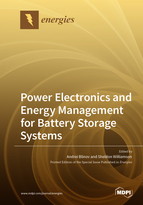Power Electronics and Energy Management for Battery Storage Systems
A special issue of Energies (ISSN 1996-1073). This special issue belongs to the section "D2: Electrochem: Batteries, Fuel Cells, Capacitors".
Deadline for manuscript submissions: closed (20 May 2022) | Viewed by 25191
Special Issue Editors
Interests: power electronic converters; batteries; power semiconductor devices; renewable energy
Special Issues, Collections and Topics in MDPI journals
Interests: battery-powered vehicles; switching converters; battery chargers; induction motor drives; power capacitors
Special Issues, Collections and Topics in MDPI journals
Special Issue Information
Dear Colleagues,
Deployment of distributed renewable generation and e-mobility systems is creating a demand for improved dynamic performance, flexibility, and resilience of the electrical grid.
Various energy storages, such as stationary and electric vehicle batteries together with power electronic interfaces, will play a key role in addressing these requests thanks to their enhanced functionality, fast response times, and configuration flexibility. However, several barriers still stand in the way of massive implementation of this technology, and the associated enabling developments are becoming of paramount importance. These include energy management algorithms; optimal sizing and coordinated control strategies of different storage technologies, including e-mobility storage; power electronic converters for interfacing renewables and battery systems, which allow advanced interactions with the grid; increase of round-trip efficiencies by means of advanced materials, components, and algorithms.
This Special Issue aims to encourage researchers to share new developments and potential solutions addressing the aforementioned and other related topics aiming to make the most out of these emerging technologies.
Dr. Andrei Blinov
Prof. Sheldon Williamson
Guest Editors
Manuscript Submission Information
Manuscripts should be submitted online at www.mdpi.com by registering and logging in to this website. Once you are registered, click here to go to the submission form. Manuscripts can be submitted until the deadline. All submissions that pass pre-check are peer-reviewed. Accepted papers will be published continuously in the journal (as soon as accepted) and will be listed together on the special issue website. Research articles, review articles as well as short communications are invited. For planned papers, a title and short abstract (about 100 words) can be sent to the Editorial Office for announcement on this website.
Submitted manuscripts should not have been published previously, nor be under consideration for publication elsewhere (except conference proceedings papers). All manuscripts are thoroughly refereed through a single-blind peer-review process. A guide for authors and other relevant information for submission of manuscripts is available on the Instructions for Authors page. Energies is an international peer-reviewed open access semimonthly journal published by MDPI.
Please visit the Instructions for Authors page before submitting a manuscript. The Article Processing Charge (APC) for publication in this open access journal is 2600 CHF (Swiss Francs). Submitted papers should be well formatted and use good English. Authors may use MDPI's English editing service prior to publication or during author revisions.
Keywords
- Battery system
- Renewable energy source
- Energy management
- Demand response
- Power electronic converter
- Battery charger
- Bidirectional power flow
- Electric vehicles
- Wide band gap semiconductors
- Energy efficiency







